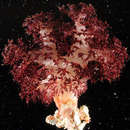en
names in breadcrumbs


Nephtheidae is a family of soft corals in the phylum Cnidaria. Members of this family are known as carnation corals, tree corals or colt soft corals. They are very attractive and show a wide range of rich and pastel colours including reds, pinks, yellows and purples. They are popular with reef aquarium hobbyists.[2]
Most of these corals are arborescent and have little knobs on the end of their rubbery branches. The coral polyps tend to retract in the daytime which gives these corals their alternative name of broccoli corals because of their resemblance to the vegetable. At night the polyps emerge and extend their tentacles to feed, looking like little bunches of flowers on the ends of the branches.[3]
The World Register of Marine Species includes the following genera in this family:[4]
Nephthya sp.
Scleronephthya sp.
Nephtheidae is a family of soft corals in the phylum Cnidaria. Members of this family are known as carnation corals, tree corals or colt soft corals. They are very attractive and show a wide range of rich and pastel colours including reds, pinks, yellows and purples. They are popular with reef aquarium hobbyists.
Most of these corals are arborescent and have little knobs on the end of their rubbery branches. The coral polyps tend to retract in the daytime which gives these corals their alternative name of broccoli corals because of their resemblance to the vegetable. At night the polyps emerge and extend their tentacles to feed, looking like little bunches of flowers on the ends of the branches.